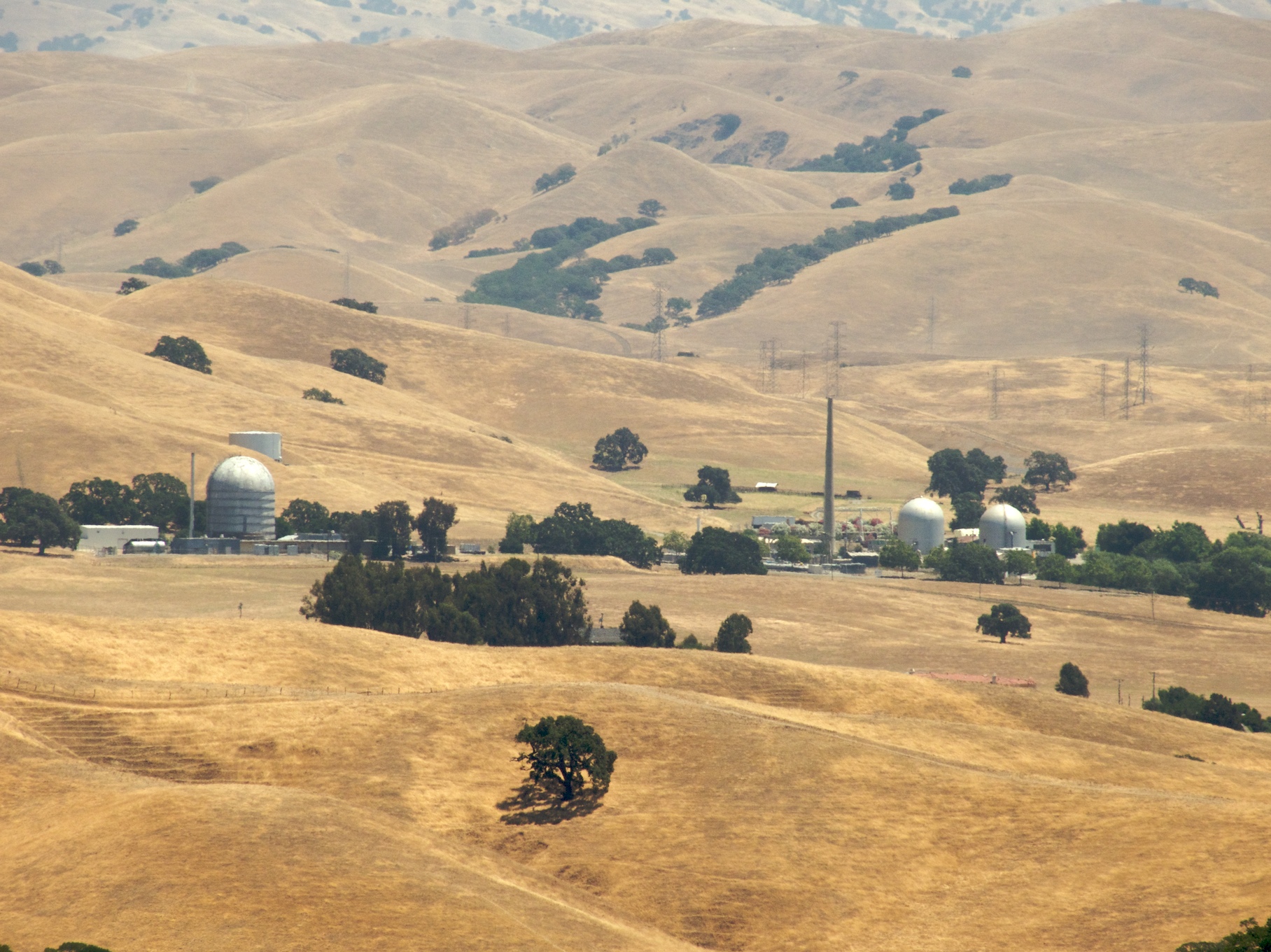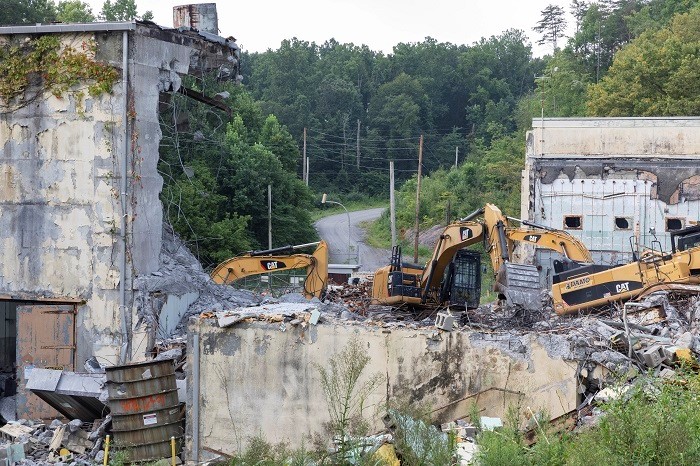The Vallecitos Nuclear Center in northern California. (Photo: Wikimedia Commons)
GE Hitachi Nuclear Energy announced May 9 that it intends to transfer ownership of the 1,600-acre GEH Vallecitos Nuclear Center to NorthStar Group Services for nuclear decontamination, decommissioning, and environmental site restoration.
Crews recently replaced a motor in a crane at the SRS H Canyon for the first time in the facility’s 70-year history. (Photo: DOE)
Work crews at the Department of Energy’s Savannah River Site in South Carolina recently replaced a motor on a crane in the 70-year-old H Canyon Chemical Separations Facility. H Canyon is the only production-scale, radiologically shielded chemical separations plant in operation in the United States.
The SSSB wet pit, which once held spent naval nuclear fuel, is demolished. (Photo: APTIM)
Nuclear dismantling and decommissioning company APTIM said it is on schedule to wrap up field activities decommissioning the U.S. Navy’s Surface Ship Support Barge (SSSB) by April, with project closure slated for June. The company announced yesterday that its team has completed the demolition of the barge’s former spent fuel water pool, also referred to as the “wet pit,” or the heart of the vessel.
The NS Savannah, the world’s first nuclear-powered merchant ship. (Photo: NARA)
The U.S. Department of Transportation has drafted a programmatic agreement (PA) on the decommissioning the NS Savannah, the world’s first nuclear-powered merchant ship. Christened in 1959 under President Dwight Eisenhower’s Atoms for Peace initiative, which challenged world leaders to develop peaceful uses of nuclear power, the ship served as a demonstration project for the potential maritime use of nuclear energy.
Construction is underway on the Paducah Site's new Emergency Operations Center. (Photo: DOE)
Construction crews at the Department of Energy's Paducah Site in Kentucky have broken ground on a new Emergency Operations Center (EOC) to improve coordination and response to emergencies across the site.
The 3,500-square-foot facility will replace the existing EOC, which was established in the site’s C-300 Control Building around 1990. The C-300 Control Building was built during the 1950s. The new modern facility will be used to monitor environmental conditions and house emergency management personnel.
The new EOC is scheduled for completion in this year.
A video is available on the construction of the new EOC.
A screen capture from the DOE's West Valley video. (Image: DOE)
A new animated video from the Department of Energy's Office of Environmental Management (EM) shows how cleanup contractor CH2M HILL BWXT West Valley (CHBWV) will take down the main plant process building at the West Valley Demonstration Project (WVDP).
The EM team at West Valley wanted to convey the project to the public, and they believe the animation accomplishes that goal, according to Stephen Bousquet, EM WVDP federal project director for the Main Plant Deconstruction Project.
Click here to watch the video.
The Ignalina nuclear power plant. (Photo: INPP)
A consortium comprising Westinghouse Electric Spain, Jacobs, and the Lithuanian Energy Institute has been selected to plan dismantling and waste management at the long closed two-unit Ignalina nuclear power plant in Lithuania.
An aerial view of Hanford’s Plutonium Uranium Extraction plant, showing the main facility (at center), the 211-A chemical storage area, and (in foreground) the 203-A acid storage area. (Photo: DOE)
Work crews at the Department of Energy’s Hanford Site in Washington state are performing risk-reduction activities at the Plutonium Uranium Extraction (PUREX) plant to prepare it for eventual disposition.
“It will be a yearslong effort to get this large facility ready for disposition, and I’m encouraged by the progress to safely and efficiently advance this work,” said Andy Wiborg, the DOE’s Projects and Facilities Division team lead for Hanford’s Central Plateau cleanup project.
Crews completed the teardown of Oak Ridge’s Bulk Shielding Reactor (Building 3010), once used for research as part of the federal Aircraft Nuclear Propulsion Program. (Photos: DOE)
The Department of Energy’s Office of Environmental Management (EM) said its cleanup contractor UCOR recently completed the first-ever demolition of a reactor in the central campus area at the Oak Ridge National Laboratory in Tennessee.
On the left, equipment being installed at Indian Point-3 on April 26, 1971. Unit 3 began operation in August 1976. On the right, some of the same equipment being removed as part of the decommissioning process, November 2022. (Photo: Indian Point Energy Center)
Holtec continues the decommissioning work at Indian Point nuclear power plant in Buchanan, N.Y.
Unit 2, a 1,028-MWe pressurized water reactor, was shut down in April 2020; Unit 3, a 1,041-MWe PWR, was closed one year later. (Unit 1 was decommissioned in 1974.)
DOE contractor CPCCo recently completed construction of a protective cocoon over the former K East Reactor building at Hanford. (Photo: DOE)
The Department of Energy’s Office of Environmental Management (EM) announced that construction of Hanford’s K East Reactor cocoon has been completed ahead of schedule and under budget. Cocooning of K East—enclosing it in a protective steel structure while the reactor’s radioactivity naturally decays—was one of EM’s key construction priorities for 2022.
A view of the Savannah River Site’s H Area. (Photo: DOE)
The Department of Energy’s Office of Environmental Management (EM) announced on October 18 that it has begun the process of transferring primary authority of South Carolina’s Savannah River Site (SRS) to the National Nuclear Security Administration, with the transfer expected to be completed in 2025.
Workers dismantle the conveyors of a coal-handling system at the Savannah River Site’s D Area. (Photo: SRNS)
Workers at the Department of Energy’s Savannah River Site have achieved an 85 percent reduction in the site’s operational footprint, a percentage that will grow as decommissioning and demolition of facilities continue in the site’s massive D Area, according to the DOE.
Crews make progress tearing down the former Criticality Experiment Laboratory. The teardown began this past summer after months of deactivation activities. (Photo: DOE)
Work crews at the Department of Energy’s Oak Ridge Site in Tennessee have successfully completed the demolition of the former Criticality Experiment Laboratory. Crews worked this past summer to bring down the dilapidated 1940s-era facility, also known as Building 9213.




 The Nuclear Decommissioning Authority, the governmental organization responsible for the cleanup and decommissioning of the United Kingdom’s 17 nuclear sites, has released its business plan for the fiscal years running from April 1, 2023, through March 31, 2026. The plan provides a summary of the activities and progress the NDA expects to make at its nuclear sites over the next three years.
The Nuclear Decommissioning Authority, the governmental organization responsible for the cleanup and decommissioning of the United Kingdom’s 17 nuclear sites, has released its business plan for the fiscal years running from April 1, 2023, through March 31, 2026. The plan provides a summary of the activities and progress the NDA expects to make at its nuclear sites over the next three years.










